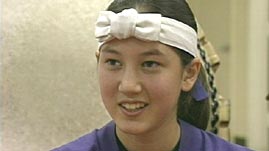Teachers' Domain - Digital Media for the Classroom and Professional Development
User: Preview


Source: ZOOM
(footsteps) (knocking)
HANA G.: (playing classical music) I'm Hana, and I'm from Los Angeles, California. Music is important in someone's life. It brings a part of you out instead of... like for people who don't really like to speak a lot play different instruments and I don't love to speak a lot and so I play instruments, and it kind of brings myself out and shows people who I am. (loud, intense drumming)
One reason I joined this taiko group was because of my Japanese culture. I'm half Japanese so I wanted to learn more and be exposed to my Japanese side. The word “taiko” means "big sound" or "drum" in Japanese.
This is one of the drums that we play. It's called a “chu-daiko,” which is "middle drum" and it's made out of cowhide here and a hollow tree trunk. It makes a really big sound.
Kids first join the group, ages seven and up and it takes about two years to be able to perform. They usually start out with this drum. It's called “shime” and it means "little drum" and it keeps the beat for the rest of the people.
The reason why we stare straight ahead-- we kind of stare past the wall— is to keep our concentration. It keeps us focused and able to hit the drums. During the performance, a lot of the drummers they say things like... (speaks Japanese words) and that's to cheer them on.
(drums beating) (speaking Japanese)
These drums are very hard to play. You have to have nice movements and you have to look good and you just hit it as hard as you can. A long time ago, taiko was only played by men or boys and girls weren't allowed to play because they were thought of as kind of weak. It's great that girls can show their strength and ability and they're just like the guys. They can play just as hard or even harder sometimes.
When I play the drums, I feel strong and excited. It gets me excited. And since it's with a group we all kind of cheer each other on and it makes me feel a part of everyone and equal.
 Loading Standards
Loading Standards Teachers' Domain is proud to be a Pathways portal to the National Science Digital Library.
Teachers' Domain is proud to be a Pathways portal to the National Science Digital Library.
